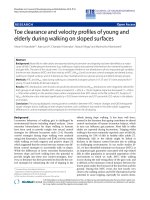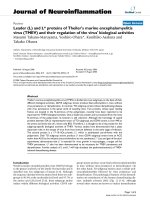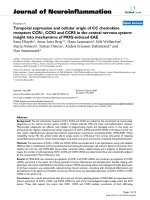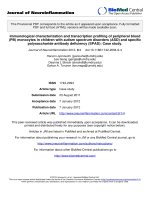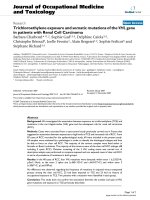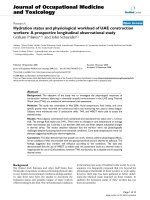báo cáo hóa học:" Density-equalizing mapping and scientometric benchmarking of European allergy research" potx
Bạn đang xem bản rút gọn của tài liệu. Xem và tải ngay bản đầy đủ của tài liệu tại đây (1.35 MB, 8 trang )
RESEA R C H Open Access
Density-equalizing mapping and scientometric
benchmarking of European allergy research
Cristian Scutaru
1,2
, David Quarcoo
1
, Mohannad Sakr
1
, Awfa Shami
1
, Khaled Al-Mutawakel
1
, Karin Vitzthum
1*
,
Tanja C Fischer
3
, Torsten Zuberbier
3
, Beatrix Groneberg-Kloft
4
Abstract
Due to the great socioeconomic burden of allergic diseases, research in this field which is important for environ-
mental medicine is currently increasing. Therefore the European Union has initiated the Global Allergy and Asthma
European network (GA2LEN). However, despite increasing research in the past years detailed scientometric analyses
have not been conducted so far. This study is the first scientometric analysis in a field of growing interest. It ana-
lyses scientific contributions in Europ ean allergy research between 2001 and 2007. Three different meetings of the
European Academy of Allergy and Clinical Immunology were analysed for contributions and an increase in both
the amount of research and networks was found.
Introduction
Allergic diseases are complex inflammatory conditions
with an increasing prevalence and incidence [1]. They
play a major role in environmental and occupational
medicine and encompass i.e. allergic bronchial asthma
[2], allergic rhinitis [3], atopic dermatitis [4], food allergy
[5] and allergic eye diseases [6]. The direct medical costs
evolved from allergic diseases are increasing over the
past decades. I.e. bronch ial asthma constitutes about an
estimated 1-3% of the health fund of the U.S and the
economic burden amounts to roughly 12 billion dollar
[7-9]. Also other allergic diseases exert a major toll on
the heath care systems [10]. Despite the large amount of
clinical and experimental studies already conducted on
allergic diseases, further insights into the molecular
basics are required to develop new therapeutic
strategies.
Therefore, the European Union (EU) started a network
of excellence, bringing together epidemiological and
clinical researchers w ho investigate allergy and asthma
across the life stages. Launched as a Network of Excel-
lenceof25leadingEuropeanteamsaswellasthe
European Academy of Allergology and Clinical Immu-
nology (EAACI) and the European Federation of Allergy
and Airways Diseases Patients Associations (EFA) on
February 2004, a total budget of EUR 14.4 million for a
five-year period has been allocated from the EU’sSixth
Research Framework Progra mme for GA2LEN activitie s
[11]. GA
2
LEN’s research examines new ways of under-
standing, preventing and managing allergies and asthma.
Research activities focus on epidemiology; early life
events in the development of sensitisation; the transla-
tion of allergic sensitisation into allergic disease; the per-
sistence in aggravation of allergic diseases and asthma.
The collaboration project reflects recognition of growing
concern among European citizens about rising rates of
allergy and asthma [12]. In this respect the scientific
community depends on annual meetings to propagate
the novel insights. The European Academy of Allergy
and Clinical Immunology (EAACI) has already 26
annual congresses. However, there is no in-depth scien-
tometric analysis of allergy research available so far.
Therefore the present study was carried out to evaluate
European allergy research using these congresses in the
light of a growing interest in allergy research. Biblio-
metric approaches in combination with density-
equalizing mapping were used for this purpose.
We hypothesized that the growing interest in allergy
research is reflected by the output of abstracts at the
largest European allergy meetings. Furthermore we were
interested in investigating whether the creation of
research networks such as the GA2LEN might influence
scientific cooperation among EU countries.
* Correspondence:
1
Institute of Occupational Medicine, Charité-Universitätsmedizin Berlin, Free
University Berlin and Humboldt-University Berlin, Berlin, Germany
Scutaru et al . Journal of Occupational Medicine and Toxicology 2010, 5:2
/>© 2010 Scutaru et al; licensee BioMed Central Ltd. This is an Open Access article distributed under the terms of the Creative Commons
Attribution License ( which permits unrestricted use, distribution, and reproduction in
any medium, provided the original work is properly cited.
Methods
Data source
Data was retrieved from the over 1500 pages of the pro-
ceedings books of the three different annual meetings in
Berlin, Vienna and Gotenborg [13].
Data acquisition
Data from the abstract books was entered into Excel
spreadsheets following the subsequent rules: 1) The
country from which the author of the article comes is
inserted into the database program (Excel) 2) If an arti-
cle is a result from a multinational cooperation (authors
from different countries) each land is inserted in to the
database program.
Data analysis
The following parameters were screened: 1) Numbe r of
abstracts originating from a specific country. 2) National
interests for the field of allergy over the years (number
of abstracts over the years) 3) Global analysis of the par-
ticipations using density equalizing maps 4) Develop-
ment of international cooperations in the allergy
research.
A table was subsequently generated with all the parti-
cipant countries and the number of papers coming from
that country using Visual Basic for Applications (VBA).
Density-equalizing mapping
Density-equalizing mapping was used as described pre-
viously [14-16]. In brief, terri tories were re-si zed accord-
ing to a particular variable, i.e. the number of published
items at the three congresses. For the re-sizing procedure
the area of each country was scaled in proportion to its
total number of p ublished ite ms. The specific calcula-
tions are based on Gastner and Newman’s algorithm [17].
Analysis of bilateral and multinational cooperations
A bilateral cooperation between 2 countries was defined
when at least one author originates from one country
and at least one other author from a second country.
A matrix with all participant countries was computed
with special software and filled with the appropriate
values for the cooperation for each pair of countries. A
software program was developed to interpret the matrix
and transform the figures into vectors. The thickness of a
vector quantifies the cooperation between the two coun-
tries. A threshold was also programmed in order to filter
low numbers of bilateral cooperations (i.e. less then 5).
Results
Total number of published items
The number of published items was used as an index of
quantity of research productivity and large differences
were found: At the 2001 annual meeting 904 items were
published by 58 countries (Fig. 1). At the 2006 meeting
1713 items were published by 75 countries and at the
2007annualmeeting1653items were published by 74
countries (fig. 2). The most productive countries were in
2001 Germany (159 items) followed by Spain (122
items), Italy (74 items), Poland (73 items) and the Rus-
sian Federation (51 items) while in 2006, Spain was the
most productive country with 226 published items
followed by Germany (169 items), Austria (114 items),
Italy (112) and Poland (112). At the last congress in
Sweden, Spain was again the most productive country
(243 items) followed by Germany (167 items), Sweden
(134 items), Portugal (122 items) and Italy (92 items).
Assessment of trends for single countries between the
three congresses illustrates different trends: A general
increase in numbers of published items can be seen.
Countries including Poland,Austria,Iran,Franceand
Turke y had a prominent contribution at the 2006 meet-
ing and decreased numbers of published items in 2007
(Fig. 1).
Density equalizing mapping
Density-equalizing mapping was used according to a
recently published method t o illustrate focuses of
research by territorial resizing. It was found that the
hosting countries dominated the meetings in terms of
numbers of presented studies: In every meeting in Ger-
many (Fig. 2), Austria (Fig. 3) and Sweden (Fig. 4), they
were listed within the top 3 most productive countries.
Apartfromthishost-dependanttrend,Spainwasalso
very active.
Networks
The biggest change lies in the cooperation between dif-
ferent countries. This can probably be explained due the
faster and cheaper means of communications and the
increasing founding of European networks. In specific,
at the 2001 meeting in Munich, networks were domi-
nant between Germany and the US and Germany and
Austria. However, the total numbers of bilateral coop-
erations (> 10 bilateral) were little (Fig. 2). An increase
of bilateral cooperation (number > 10) was found for
the 2006 meeting in Sweden. Here German-Austrian
networks dominated (Fig. 3). At the 2007 meeting,
German scientist s again had the highest nu mber of
bilateral cooperations (Fig. 4).
Discussion
The present study is the first analysis to assess allergy
research progress using scientometric methods in com-
bination with density-equalizing mapping procedures.
An increasing number of networks was found when
Scutaru et al . Journal of Occupational Medicine and Toxicology 2010, 5:2
/>Page 2 of 8
Figure 1 Published items at the annu al meetings of the European Academy of Allergy and Clinical Immunology. A total number of
contributions at the Berlin (2001), Vienna (2006) and Gotenborg (2007) meetings. B percentage of contribution for each meetings.
Scutaru et al . Journal of Occupational Medicine and Toxicology 2010, 5:2
/>Page 3 of 8
Figure 2 Contribution and network analysis for the 2001 meeting. A Density-equalizing map illustrating the number of contributions for
each country. The area of each country was scaled in proportion to its total number of publications regarding the contributions. Colors encode
the number of contributions per country. B Chart visualizing the networking. Greyscale and size of bars encode the number of bilateral
cooperations.
Scutaru et al . Journal of Occupational Medicine and Toxicology 2010, 5:2
/>Page 4 of 8
Figure 3 Contribution and network analysis for the 2006 meeting. A Density-equalizing map illustrating the number of contributions for
each country. The area of each country was scaled in proportion to its total number of publications regarding the contributions. Colors encode
the number of contributions per country. B Chart visualizing the networking. Greyscale and size of bars encode the number of bilateral
cooperations.
Scutaru et al . Journal of Occupational Medicine and Toxicology 2010, 5:2
/>Page 5 of 8
Figure 4 Contribution and network analysis for the 2007 meeting. A Density-equalizing map illustrating the number of contributions for
each country. The area of each country was scaled in proportion to its total number of publications regarding the contributions. Colors encode
the number of contributions per country. B Chart visualizing the networking. Greyscale and size of bars encode the number of bilateral
cooperations.
Scutaru et al . Journal of Occupational Medicine and Toxicology 2010, 5:2
/>Page 6 of 8
2001 scientific activities were compared to 2006 and
2007. This needs to be interpreted in the context of
allergy research and funding: Allergic diseases are esti-
mated to cost Europe about 25 billion Euros annually,
with most of the costs due to reduced productivity in
school or at work and there is in increasing burden of
allergic diseases present in Europe. Therefore, the Eur-
opean Union started the GA2LEN network with the
intention to establish a world-wide competitive network
of European centres of excellence in order to enhance
the quality and relevance of research in the area of
allergy and to address allergy and asthma in their total-
ity. The research network focuses its research pro-
gramme on developing new ways of preventing and
managing allergies and asthma. In the long term, the
research network aims also to decrease the socioeco-
nomic burde n of allergy and asthma in Europe. In close
association to these aims are the meetings of the Eur-
opean Academy of Allergy and Clinical Immunology.
They provide substantial progress in knowledge along
with offering the opportunity for scientific networking
and exchanging ideas. Due to the fact that there has
been such an inflow of information surrounding allergy,
it was decided in 1999 that there would be a four-day
Congress every year. Generally, there is a constant
increase of interest in this field since the meeting in
2001. The growing interest in the subje ct can also be
seen when the most productive countries are analyzed.
Data analysis of productivity parameters shows that
research groups from Spain maintain a leadership posi-
tion in research productivity at the level of European
allergy meetings. The tendency of only a relatively small
number of countries contributing the majority of
research at the three congresses can also be remarkably
illustrated by density-equalizing mapping procedures.
Whereas the number of published items was cur-
rently considered as an index of quantity of research
productivity, the average citation per item may be used
as an indicator for research quality. However, this
approach is not available in the current study since the
meeting abstracts are not listed in the PubMed online
library and therefore not cited by many articles. How-
ever, online database-related studies have pe rformed
citation analyses for subfields of allergy research such
as animal models of asthma [15]. In these studies it
was shown that there is a major difference between
research quantity as asse ssed by numbers of published
items and research quality as assessed by citation para-
meters. Data was retrieved from the Thomson Institute
for Scientific Infor mation database Web of Science
[18]. During the period from 1900 to 2006 a number
of 3489 filed items were connected to animal models
of asthma, the first being published in the year 1968
[15]. The studies were published by 52 countries with
the US, Japan and the UK being the most productive
suppliers, representing 55.8% of all published items.
Analyzing the average citation per item as an indicator
for research quality, Switzerland ranked first (30.54/
item)andNewZealandrankedsecondforcountries
with more than 10 published studies [15]. With regard
to the differences in this study on animal models, one
can not draw any implications for the quality of
science at the three currently analyzed allergy meet-
ings. For this purpose, citation analyzing procedures
arerequiredthatcannotbeappliedinthepresent
analysis of abstract books.
For the present study, it is important to realise that
the analysis of European meetings are not representative
for global allergy research. In this respect, a bias is
represented by the host countries. Each of the three
host countries is over-represented in its own meeting.
This is a common phenomenon of conferences. There-
fore, future studies using online data bases such as the
PubMed or the Thomson Institute for Scientific Infor-
mation database Web of Science [18] might be used to
gene rate an overview of global allergy research activities
using previously described techniques encompassing
both scientometric and visualizing tools [19-22]. This
might be performed within the NewQIS platform
[23,24].
Conclusion
The present study represents the first detailed biblio-
metric analysis of European allergy research. The data
shows a strong increase in research productivity. In
future, internationally established databases such as the
Web of Science or the PubMed should be analyzed in
combination with novel tools such as density- equalizing
mapping.
Author details
1
Institute of Occupational Medicine, Charité-Universitätsmedizin Berlin, Free
University Berlin and Humboldt-University Berlin, Berlin, Germany.
2
Department of Respiratory Medicine, Hanover Medical School, Hanover,
Germany.
3
Allergy-Centre-Charité, Department of Dermatology and Allergy,
Charité-Universitätsmedizin Berlin, Free University Berlin and Humboldt-
University Berlin, Berlin, Germany.
4
Otto-Heubner-Centre, Charité-
Universitätsmedizin Berlin, Free University Berlin and Humboldt-University
Berlin, Berlin, Germany.
Authors’ contributions
BGK, CS, and DQ designed the study. CS, MS, AS, and KA performed the
search routines and constructed the different data files. DQ and KV
performed pilot data search routines and analysis. CS, DQ, MS, AS, KA, TCF,
TZ, KV and BGK participated in the discussion of the data and manuscript
drafting. All authors have read and approved the final version of the
manuscript.
Competing interests
The authors declare that they have no competing interests.
Received: 26 November 2009 Accepted: 16 February 2010
Published: 16 February 2010
Scutaru et al . Journal of Occupational Medicine and Toxicology 2010, 5:2
/>Page 7 of 8
References
1. Nauta AJ, Engels F, Knippels LM, Garssen J, Nijkamp FP, Redegeld FA:
Mechanisms of allergy and asthma. Eur J Pharmacol 2008, 585:354-360.
2. Apter AJ: Advances in the care of adults with asthma and allergy in
2007. J Allergy Clin Immunol 2008, 121:839-844.
3. Ahmad N, Zacharek MA: Allergic rhinitis and rhinosinusitis. Otolaryngol
Clin North Am 2008, 41:267-281.
4. Giannetti A, Girolomoni G: Skin diseases with high public health impact.
Atopic dermatitis. Eur J Dermatol 2007, 17:566.
5. Lack G: Epidemiologic risks for food allergy. J Allergy Clin Immunol 2008,
121:1331-1336.
6. Bielory L: Ocular allergy overview. Immunol Allergy Clin North Am 2008,
28:1-23.
7. Redd SC: Asthma in the United States: burden and current theories.
Environ Health Perspect 2002, 110(Suppl 4):557-560.
8. Weiss KB, Gergen PJ, Hodgson TA: An economic evaluation of asthma in
the United States. N Engl J Med 1992, 326:862-866.
9. Weiss KB, Sullivan SD, Lyttle CS: Trends in the cost of illness for asthma in
the United States, 1985-1994. J Allergy Clin Immunol 2000, 106:493-499.
10. Mancini AJ, Kaulback K, Chamlin SL: The socioeconomic impact of atopic
dermatitis in the United States: a systematic review. Pediatr Dermatol
2008, 25:1-6.
11. Munoz-Lopez F: Ga2Len: coordinated research. Allergol Immunopathol
(Madr) 2005, 33:243-244.
12. Frew AJ: GA2LEN–The Global Allergy and Asthma European Network.
Clin Exp Allergy 2005, 35:122-125.
13. XXVI Congress of the European Academy of Allergology and Clinical
Immunology, Abstract Book, Gotenborg, Sweden. Allergy 2007, 62.
14. Groneberg-Kloft B, Scutaru C, Kreiter C, Kolzow S, Fischer A, Quarcoo D:
Institutional operating figures in basic and applied sciences:
Scientometric analysis of quantitative output benchmarking. Health Res
Policy Syst 2008, 6:6.
15. Borger JA, Neye N, Scutaru C, Kreiter C, Puk C, Fischer TC, Groneberg-
Kloft B: Models of asthma: density-equalizing mapping and output
benchmarking. J Occup Med Toxicol 2008,
3(Suppl 1):S7.
16. Groneberg-Kloft B, Kreiter C, Welte T, Fischer A, Quarcoo D, Scutaru C:
Interfield dysbalances in research input and output benchmarking:
visualisation by density equalizing procedures. Int J Health Geogr 2008,
7:48.
17. Gastner MT, Newman ME: From The Cover: Diffusion-based method for
producing density-equalizing maps. Proc Natl Acad Sci USA 2004,
101:7499-7504.
18. Sevinc A: Multilingual approach to “Web of Science”. J Natl Med Assoc
2005, 97:116-117.
19. Kusma B, Scutaru C, Quarcoo D, Welte T, Fischer TC, Groneberg-Kloft B:
Tobacco control: visualisation of research activity using density-
equalizing mapping and scientometric benchmarking procedures. Int J
Environ Res Public Health 2009, 6:1856-1869.
20. Groneberg-Kloft B, Scutaru C, Fischer A, Welte T, Kreiter C, Quarcoo D:
Analysis of research output parameters: density equalizing mapping and
citation trend analysis. BMC Health Serv Res 2009, 9:16.
21. Groneberg-Kloft B, Scutaru C, Dinh QT, Welte T, Chung KF, Fischer A,
Quarcoo D: Inter-disease comparison of research quantity and quality:
bronchial asthma and chronic obstructive pulmonary disease. J Asthma
2009, 46:147-152.
22. Groneberg-Kloft B, Dinh QT, Scutaru C, Welte T, Fischer A, Chung KF,
Quarcoo D: Cough as a symptom and a disease entity: scientometric
analysis and density-equalizing calculations. J Investig Allergol Clin
Immunol 2009, 19:266-275.
23. Groneberg-Kloft B, Quarcoo D, Scutaru C: Quality and quantity indices in
science: use of visualization tools. EMBO Rep 2009, 10:800-803.
24. Groneberg-Kloft B, Fischer TC, Quarcoo D, Scutaru C: New quality and
quantity indices in science (NewQIS): the study protocol of an
international project. J Occup Med Toxicol 2009, 4:16.
doi:10.1186/1745-6673-5-2
Cite this article as: Scutaru et al.: Density-equalizing mapping and
scientometric benchmarking of European allergy research. Journal of
Occupational Medicine and Toxicology 2010 5:2.
Submit your next manuscript to BioMed Central
and take full advantage of:
• Convenient online submission
• Thorough peer review
• No space constraints or color figure charges
• Immediate publication on acceptance
• Inclusion in PubMed, CAS, Scopus and Google Scholar
• Research which is freely available for redistribution
Submit your manuscript at
www.biomedcentral.com/submit
Scutaru et al . Journal of Occupational Medicine and Toxicology 2010, 5:2
/>Page 8 of 8


